Sheryl Knowles Interview
Author notes: - I was introduced to Sheryl by somebody else from the original WorldsAway team in 2020. Sheryl was very kind with her time and shared so much of herself in this interview. It's really was a pleasure to talk to somebody who contributed to much to this piece of software that means so much to us. A true legend in the industry.
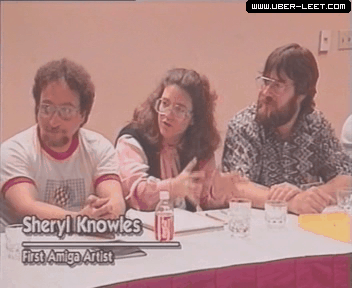
How did you get started as an artist originally?
I’ve been drawing ever since I could hold a pencil. In high school and college, however, I concentrated on the sciences (starting in physics but graduating in anthropology & linguistics). Computer science was just being introduced, as part of the math department at Oregon State University, and it fascinated me. So I developed my own program in computational linguistics. Back then it was thought that machine translation of human language was right around the corner! We were wrong <smile>, but I developed a lot of computer-related skills. I also took art classes to relax from the heavy science class load, and worked on a Lord of the Rings animation project in my spare time. There was no thought that such an eclectic education could ever be remotely useful in a single career.
I was wrong. All of that meant that when I landed in the South Bay near the start of the Silicon Valley flowering, it was something like the right skill set at the right time. I was doing freelance illustration and cartooning at the time, but my friends all knew I’d studied programming. Thus when the Amiga project needed an artist who could actually talk programming, I got tapped.
How did you transition into what is now known today as Pixel Art?
The Amiga was originally envisioned as a game machine, given that some of its original staff came out of Atari and other parts of the Arcade game industry. I was hired to make art that would help show off the machine’s capabilities. Of course, the Amiga machine didn’t actually exist, nor did any of the art tools that are so ubiquitous now. I got to design fonts on graph paper and input them using programmer tools. So to with the original art that I did: drawn on other machines but animated on the Amiga prototype hardware.
I worked on the design of the plastic box that encased the hardware; icons, etc., art for what is now known as User Interface; and illustrations for the manuals (all produced before our prototype Amigas had the capacity to SAVE; we (there were 2 of us by this stage) had to photograph our screens … and then start drawing the next illustration). We drew, literally, pixel by pixel. (I said there was no software, didn’t I? No line-draw tools, no fill tools, no manipulative tools at all. Just pixels. Big pixels.)
My last big project for Amiga was to design/spec out Artcraft, the art tool that was packaged with the Amiga. The deadline was so tight that I would draw - pixel by pixel - an illustration (for the manual) of how one of the ArtCraft tools would work, photograph the illustration, hand the illustration to the programmer, and he would program the tool to do just what I had said it should. We did that feature by feature. RJ Mical was a phenomenal programmer!
The Amiga was my professional working art tool up until the point that Deluxe Paint for the IBM came out.
How did you get involved with the Society for Creative Anachronism? I’d heard that’s where you met the people who you later on went to work at Fujitsu with.
At that time, I was Art Director/animator for Epyx which produced games for the Commodore, Apple II, and early IBM. I was animating a sword battle for some game, and complaining to an rpg-gaming friend that my animation was all based on the fencing I had done in college. (The fencing coach didn’t even want his female team to watch the male team’s sabre practise, as women were only allowed to work with fencing foils back in the day.) My animation just didn’t look right to me. He volunteered to take me to an SCA event: I’d bring the food for a weekend, he’d provide the transportation, tent, costuming, etc.. It was amazing!
I watched the heavy fighters all day, exclaiming “I’ve been doing it all WRONG!”. I got drenched (March rains), sprained my ankle and had an absolutely wonderful time. I love history, and all the talk about honour and chivalry were things I missed in the Big Business workplace. I was hooked from that very first event. Drew lots of SCA-based illustrations and made lots of great friends, some of whom, as you noted, have provided leads to my working on great projects - including WA - for most of my artistic career. ((Karen, Chris, Julie, Mary - I love you!))

How did you get started at Fujitsu? Do you remember when you started there?
According to my resume, I became an employee at Fujitsu in 1995. I started working for them in 1994. I’m not very good at remembering dates.
I was originally hired by Fujitsu for the WorldsAway project to animate the first 3 bodies. I may have been a freelancer at the time; I’d have to check my records. Preliminary art had already been done for both sides of the initial “town square” backgrounds, inspired by some of Antoni Gaudi’s architectural styles. Basically building fronts. And that partial ship as seen in the above picture. (I believe the original story idea was that you’d board a ship and come to the Dreamscape.) Nothing else really, other than some heads, and the body design and animation style had already been set by the two people in charge of the creative end of the project at that time, Paul and Joyce. (I might have their surnames somewhere, but I no longer can bring them to mind. Though I do remember what they looked like. <smile> An artist’s memory. <grin>).
I ended up persuading them to add a few frames to smooth out the animations, and showed a method of changing colors, but was otherwise rather stuck with the designs and specs I’d been given. By the time I finished those animations, I’d been giving enough art and idea suggestions and working closely enough with the programmers (having studied programming in college) that I was offered the Art Director’s position because my predecessors were opting to leave the project.
From that time forward, I did most of the basic art for the project, hiring freelancers to do various parts (particularly faces) so that my own art style did not completely dominate the project. I also relied on the technical art staff I hired and trained to do the world building, and to use the elements I created in as varied and interesting ways as their own creativity urged.
I also used one contractor to build (v.1.2) the “heavy woman” body, but she used my ordinary woman body as a template and did not actually improve upon the idea. That, to me, was a disappointment, so I held off on any further body development until either I had the time or I found an artist with the capabilities I needed. I considered the “heavy woman” body to be part of the first round of bodies developed, because it lacked any innovation over the instructions I’d originally worked under.
After a couple of years, the bodies I’d animated continued to irritate me with their lack of flexibility and the limitation of their initial design. So I hired an artist I’d used before when I was art director for other companies: Karen M. She was willing to free-lance for me. I asked her to make the bodies as modulated (e.g. hand, lower arm, and upper arm all as separate units, etc.) as possible, within the restrictions of our color-changing program, and more realistic. She did that. She did them originally nude, which was not a problem for me. It aided in our being able to be flexible with them. And I knew we would not release them nude. They simply made a much better template for future body upgrades.
Normal male and normal female bodies and animations were finished before I left Avaterra. We showed the new bodies in “Tarzan and Jane” mode in one of the “Interviews with the AD” programs we did. However, I was no longer at Avaterra when (and if) they were ever inserted into the American product.
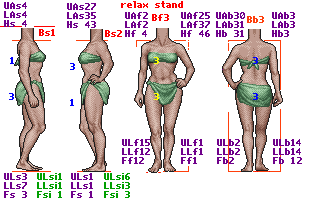
Regarding the bodies in the first image, they were screenshots from the Alpha testing stage of WorldsAway. Do you remember if these bodies were placeholders with animation? Were they ever seriously considered for the final product which shipped in November 1995?
These were the templates I was given and told to animate. The differences between these and those that made it into the “first release” WA are simply the changes I was allowed to make.
Plus, of course, the animation. The templates I was given had no animation at all. Just a list of things they had to do and the number of frames allocated for those actions, which is why, for instance, no body actually turns smoothly. <smile> I do know how to animate a human turning, but if you can only do it in the existing front-side-back frames, it will never look natural.
The Compuserve Demo proves that some animations DID exist before I came on board, but they were not made available to me. I believe I added 1 or 2 frames of walk animation per body above what was allowed in the Demo. Certainly we were never allowed to do the “transporter” animation for real <sigh> It would have been a nice way to allow skipping from area to area if you didn’t want to “walk” through screen after screen. It’s somewhat possible that the entire Demo was done in, say, Deluxe Animator, and never was part of the actual programmed product. Possible, but I don’t know how likely. I was not part of that project.
Regarding that demo, it was a demonstration of the WorldsAway technology created in Macromedia Director and released on CompuServe in early 1995. It featured quite different artwork that was never used later on and even some different features. Do you have any memories of this demo?
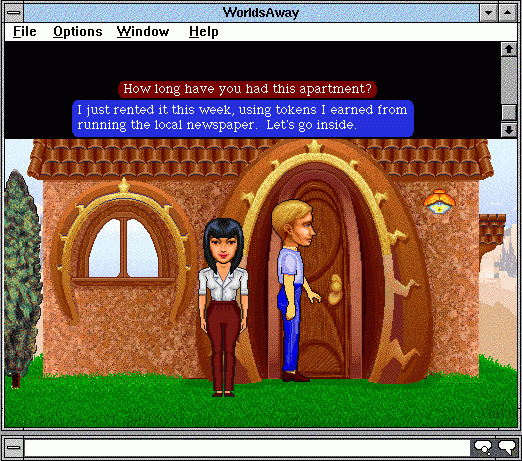
Authors note: - You can watch the video of the demo . (This will be reuploaded one day)here
I recognize the heads and bodies, but the background art looks like what was produced as “what if” before I came on board. I am sure I was not part of this demo.
You mentioned Antoni Gaudí as an early influence of some of the architectural styles. Do you remember some of your influences early on when you started to create your own artwork for the Dreamscape?
I’ve a life-time of looking at fine art. My personal library includes a huge collection of art books. But I did spend a chunk of my childhood in Japan and won’t deny that Japanese block printing has had an influence on my art. I also love much about Art Deco and Mucha’s prints, both of which seemed to work well with the WorldsAway landscape. The statuary I drew owes a debt to the Italian Renaissance.
I will note that all the wings I drew owe a tip-of-the-hat to comic book artists. I have a large comic book collection (which sometimes has been used as reference material for artists I’ve directed <smile>), and throughout most of my teen years I was frustrated by the careless way many comic book artists drew wings. So I deliberately set myself to studying actual bird wings so that I could understand how they should be drawn.
I am a big advocate of using art reference, particularly photographic animation reference. However, computer game art that did rely on actual photo references (almost always Muybridge) didn’t always realize that in the cheaper abridged publications of his work, the ubiquitous pigeon (on whom so many computer art birds are based) is coming in for a LANDING - in the best-recognized Muybridge sequence. Which means its tail is in a very wrong position if you want to animate a bird taking off, for instance. The Disney studio had the right idea with letting their animators watch real animals, real dancers, etc..
WorldsAway was the second generation version of Lucasfilm’s Habitat virtual world. When you first came aboard the project, did you go back and look at the pre-existing artwork for Habitat, Club Caribe or even Fujitsu Habitat in Japan for inspiration?
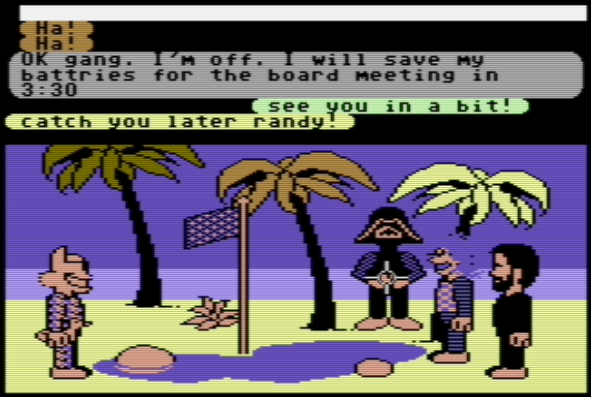
No. I recall it being mentioned, but it wasn’t made available to me. Also, the Internet was not the well-spring of art and information it is today; researching Habitat or Club Caribe would not have been easy. Unfortunately (from my point of view as a commercial artist who believes in teamwork) the Japan-Fujitsu / Silicon Valley-Fujitsu pipeline was a one way street. We gave them art and information; we did not get reciprocal return.
Do you recall anything about this screenshot featured in a Compuserve advertisement from March 1996 ? A lot of things in this picture look like a mockup, rather than a true inworld screenshot. If it was a mockup, do you know who would’ve created it?
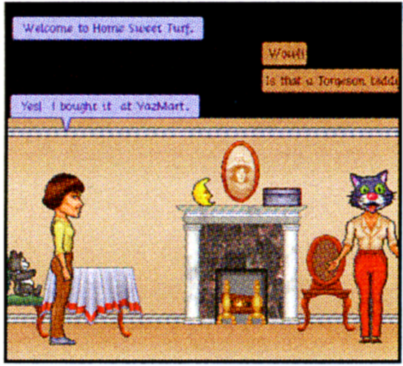
I don’t recall that exact screenshot. It looks like a user-created apartment. I don’t recall exactly when we instituted the idea that Users could have their own apartments which could be decorated as they pleased with items available from vending machines. The basic apartment was extremely simplistic: colour-changeable wall, colour-changeable floor, moldings; like this picture. I believe I actually did the head on the left.. But I did soooooo many heads that I can’t recall or even necessarily recognize them all. But, if it didn’t have changeable colours then I did not do it. The toy bear was also my work. But I can’t say as to the rest. Save that they were all elements available to my World Builders during my tenure. Thus it is possible that it was created by one of the World Builders particularly for the advertisement, under the direction of someone from sales.
You mentioned that Adobe Photoshop was used for creating artwork but were other tools ever used such as DPaint or Paint Shop Pro?
DPaint was also a big tool for us. Maybe more than Photoshop. I’ve used both so much over the years; it’s hard to remember after all this time. My inhouse staff did not, to my recollection, use Paint Shop Pro but I never limited any artist to a particular tool. As long as the file came to me in the format we required, I didn’t care what computer tool it was produced on.
I’ve heard that you created a document named “The Ten Commandments of Creating Art for WorldsAway Worlds” circa 1998 which was used for training licensees and partners of the WorldsAway technology. Do you remember what the Ten Commandments were?
The “Ten Commandments” title is a bit pretentious for me. That does not sound like a title I’d give something.
There was a list of rules for computer artists that I made when I was AD at Epyx. It followed me around through quite a few companies. But I don’t think I have a copy any more. It would be quite dated as it dealt with a time when pixels were large, colours were relatively few, and computer memory extremely limited. So the rules were designed to help artists think in terms of the limitations of a computer. One of the rules I recall is “every pixel in its place”... which referred both to what one misplaced pixel could do to alter an animation (back in those days) and to how we used juxtaposition of differently coloured pixels (“dithering”) to “create” the impression of a new colour.
I admit that a List of Rules relating exclusively to WorldsAway sounds very much like something I would have created for the enjoyment of the Users and for training artists, world builders, and customer service. But I don’t have a copy.
If you don’t remember what they were, what’s the one piece of advice you’d give to someone wanting to create artwork in the style you established for WorldsAway?
Two rules:
- In WorldsAway, light comes from above and in front. That way the pieces of art will appear like they are at least in the same room/place/world.
- When possible, make shapes organic. (That’s the Gaudi aesthetic at work.)
Is there anything you brought to your WorldsAway artwork from your earlier work? This could be art style, technique,etc..
All artists build on their previous experiences. I was very good at figuring out the minimum frames it takes to make a reasonable animation. I was also, as I’ve mentioned before, very good at adapting art styles to my own purposes. One of the things I’ve learned as an Art Director is to tell people NOT to ask me if I like a piece of art. As an AD, “like” has very little to do with anything; the question is, “does the piece of art DO what it is supposed to do?”. A secondary question is, “is there a better way for it to do what it is supposed to do?”

You previously mentioned that you brought freelancers in to create art for you, do you remember any specific pieces of art that they did that stood out to you?
For freelance art, the most memorable was Karen’s Tarzan and Jane bodies. But everyone I used contributed, simply because the project could use all the art we could come up with and still beg for more. Heads, heads, and more heads!
One of the things that must be remembered is that WA was a team effort. That actually applies to any individual screen a User ever saw. Take the coloured crystal caves, for instance. I drew every crystal. I drew a lot of individual crystals and a few clustered crystals. But it was my World Builders, Greg, Joe, and George, who actually took those crystals, recombined them, processed them, recoloured then, reused them in countless ways to create the dramatic caves. (Probably only one of them - Greg, I think - did the caves, but this is just an example.) And then again, reused the crystals with more and different pieces to create the winter snow-and-ice scenes.
I drew individual trees and tree sections, plants, constellations, rocks, statues, knicknacks, drapery, architectural pieces, furniture pieces, holiday decorations, and “backdrop” scenes. But it was the World Builders who literally created the scenes. I would Art Direct an area like Meditation Park by explaining the “feeling” or intent of the place, calling out specific areas I wanted to see - like the fishing hole and the 3 Graces area, etc. - but I would leave it up to them to actually compose the art from the pieces I gave them and the pieces already in our database. They were trained artists, after all
We’d all give each other feedback until we had a scene that felt right and magical. When I’d have time, I loved taking my avatar and just “play tourist” in all the wonderful spots my team had built.
Whereas many many of the ideas and a lot of the art pieces were mine, the finished product was ours. None of us could have done it without the others.
You mentioned that the freelancers often drew faces for heads, were heads a particular challenge for artists?
Heads were, in some sense, the biggest bang for the buck. Every User wanted unique heads for their avatar. So more different artists were used for heads than for any other element in WorldsAway. That is the only reason I associate freelancers with heads.
From almost the first it became clear that the idea of colour-changeable heads was very challenging for some artists. Most of the heads you have here were done in the early stage of the project, before I came on board. (Of course they make good illustrations for an article, because they are brightly coloured, while the later colour-changeable heads are dull in their grey-brown, grey-green, and grey-blue original state.) Many of the freelancers we tried out couldn’t adjust. They wanted to see what the User would get. Telling them that we wanted to let the User control the hair, skin and detail colours just didn’t sit well. “What if they choose HORRIBLE colours?” was the usual complaint. To me, that didn’t matter. Giving the User as much choice as possible did. Not to mention, it gave my World Builders more fodder to work with: some of the busts and statues that show up in the product are heads and bodies re-coloured to look “statue-like”.
Was there a common issue amongst artists who submitted their work for inclusion into the world? Something they tended to often get wrong the first time for example.
I don’t recall a common mistake. Every artist has his or her own idiosyncrasies. I used lots of freelancers. Their first assignment was always a “test”, from my point of view. It usually included a few sets of heads (usually left up to them to decide what sort but always one male and one female, in all positions and with all expressions) and a few “bits” of background decor (furniture, plants, architectural features like columns, doors, windows, etc.). I asked them to “show me your strengths”. They were always paid for this first assignment. But when they returned the assignment, I’d know what I could use them for or if I couldn’t use them at all again.
Colour-change was a big deal breaker. Some artists drew heads too big, some too small. Some couldn’t stay consistent from view to view, in doing the expressions required. Some artists couldn’t adjust to the artificial perspective we used. (Any artist worth their salt could criticize our perspective up the wazoo, because we didn’t really have perspective. That’s ok. It was one of our limitations.) Some artists wanted to draw entire scenes and couldn’t adjust to the idea that our scenes were all constructed from pieces. It makes sense in that artists are TRAINED to think in terms of spatial and colour composition. I was telling them they couldn’t use that training. The only artists who could actually use THAT training were our World Builders: Greg, Joe, and George.
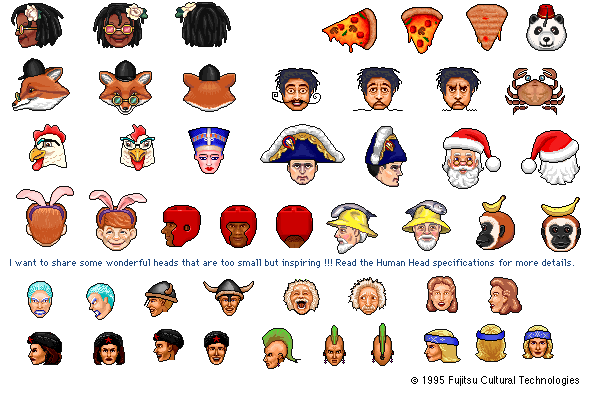
Do you remember anything about these smaller heads at all and why they were rejected?
These larger heads had the problems of (1) not being colour-changeable, (2) not being complete sets (and no one else wanted to complete them), (3) already wearing accessories (which, in the end product, were separate pieces the User could choose to wear), and - (4) in a few cases - possible copyright infringements.
The smaller heads did not fit the Head specifications. I don’t remember why they were done or if they are simply an example of an artist who didn’t pay attention to the specifications. We did specify a minimum size, simply for ease of reading facial expressions.
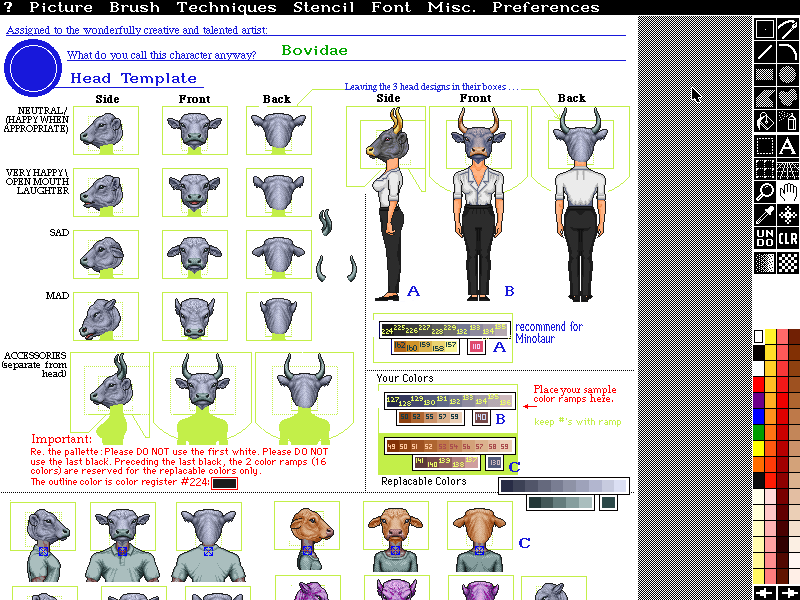
Do you recall who created this Head template sheet and was it used for every single piece of head artwork created?
I don’t remember who created this. I suspect one of my technical artists/World Builders, because they were the ones who had to put together the art in a format that would work in the WA program. If an artist didn’t draw to these templates, the tech artist would have to either reject the art or hand it to another artist for correction. No one really likes reworking something done by another artist.
But this template also could have been constructed by Karen M, who had to work closely with the technical artists because of the innovative construction requirements of her nude bodies. I simply don’t remember.
Do you remember if there was a template for bodies, accessories and such?
There were templates, some more elaborate and formal (like the one above); some more casual (like copies of the actual original art files before processing).
There certainly HAD to be templates. Anything an avatar could be allowed to sit on had to be a certain pixel count from floor to seat, or it wouldn’t look right. Door handles had to be at a certain height. Door openings had to be a minimum height. Steps had to be less than a certain height. Etc. Anything an avatar could interact with had to be made knowing where the “touch point” would be. It was the World Builders’ job to add those touch points during processing, but they had to be kept in mind when the art was being drawn.
Greg Specht mentions in his interview that there was a big binder full of printouts of every single piece of artwork created. Do you know who’s idea this was and do you know where this binder ended up?
The idea for the binder was mine. At one point, while we were still in the first building in which I worked, Fujitsu Japan required a total information dump of all the art files used in the product. At the time, that may have been over a thousand files. And <sigh> that information was only in my head. I knew every piece. So I had to sit down and fill out the form Fujitsu had sent us. Hours of typing in a spread sheet. My boss Tony Christopher allowed me time off to go get my little girl when daycare closed at 6PM, and I brought her back to the office. He fed her dinner and entertained her while I kept on typing. At the end of that, I vowed never again would a project I work on have a single-person dependency on any aspect. And never since have I been able to keep that much information organized in my head.
I think I asked Greg to make the binders. Possibly I assigned it to the World Builders as a group. I didn’t do it myself. Printing out artwork takes time, and time wasn’t something I had a lot of.
I presume the binders were at Avaterra when I left. The only art associated with WorldsAway that I took with me were my sketch books which, by contract, are my personal property.
Authors note: - After the interview had concluded, Sheryl wished to add the following clarifying response to this question.
In the commentary about the art binders I realize that I’d answered the broader concept and not the specific question. In the specific, my answer would be wrong. What I wanted - what I’d learned from my “brain download” experience - was a compilation of all the art files in non-computer format. I wanted them printed out for a “scrap file”, if you will. I did not specify “binders”. I was probably thinking “file cabinet”, but I didn’t specify. It was my world builders who brought me the results in binder format. Which in itself was genius! Far less likely for even one page of it to go missing than if they had be filed in folders in a cabinet. So the real credit goes to those guys, of whom Greg probably bore the brunt of the task. (I tended to let them divvy the tasks I assigned between themselves.)
It’s been mentioned publicly that the office space the Artists and Oracles shared was affectionately known as “The Cave”. Do you recall who came up with this nickname?
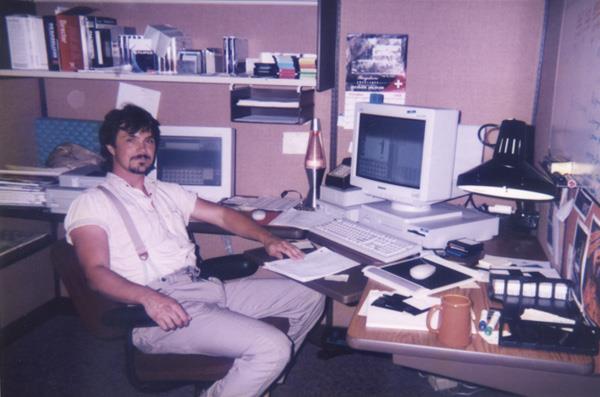
I don’t recognize that picture. (I’m not much for taking photographs except as art reference. <smile>)
About the time, or just before, Fujitsu reorganized the WorldsAway project and I was put in charge of “end user services” (art and Oracles), the company moved those two groups into an area that had been a vehicle-unloading warehouse space. (Not as big as it sounds, but adequate for the dozen or so people we had.) The longest wall of my cubicle was the corrugated aluminum door through which trucks could unload supplies, from the room’s previous use. There were no windows and we kept the lights relatively low to cut down on the glare from reflections off our computer screens. (I was aware that computer glare was a significant contributor to the headaches that computer users suffered back then.) Each cubicle had indirect and directable lighting. Each person worked in his or her own pool of light controlled by him/herself. To an outsider, coming in, it was a very dark office space. I don’t know who started calling it “The Cave”. Probably someone from outside our groups.
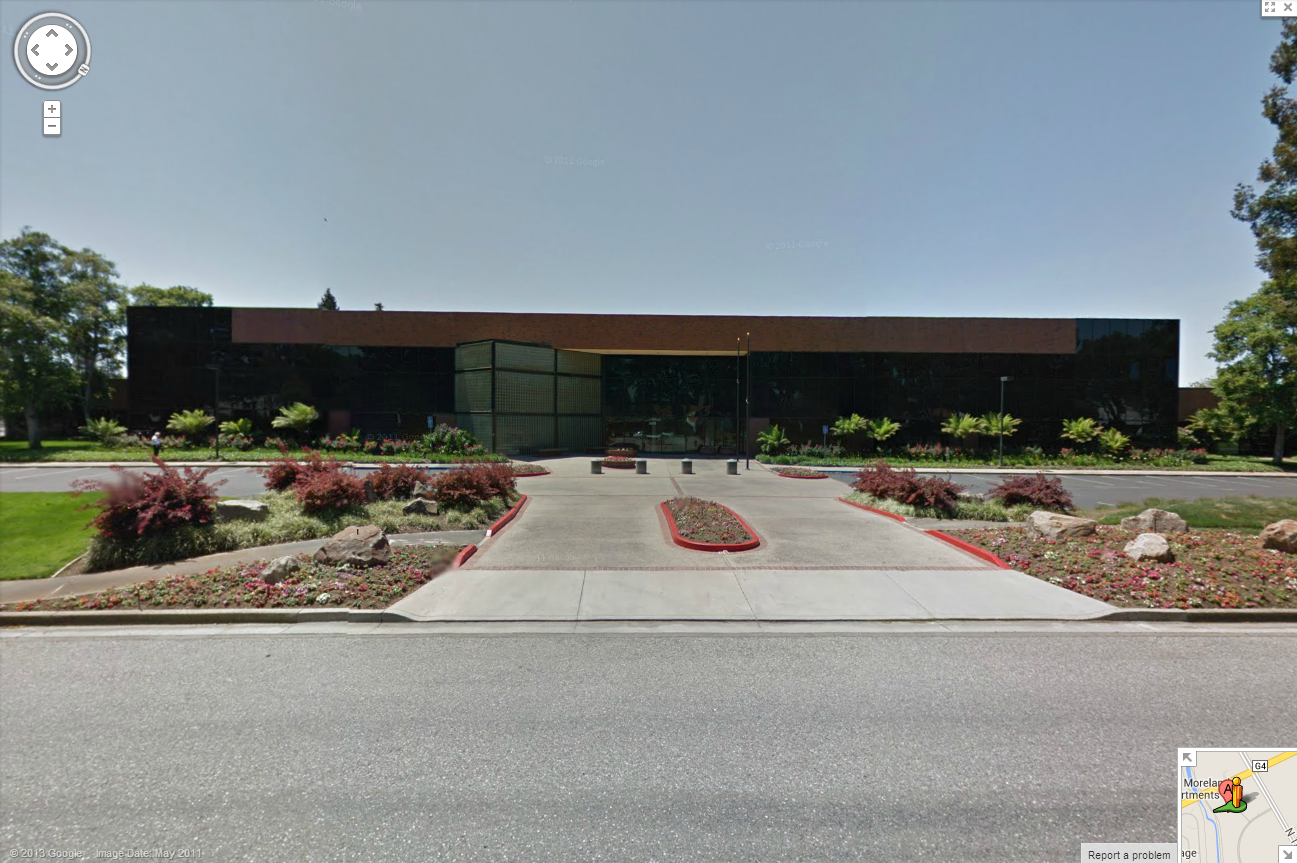
What was a typical day at the office like for you?
My day was constrained by daycare. I was once called into a meeting with the head of our branch of Fujitsu, and the meeting was threatening to extend past the deadline my daycare center had. I had to politely say, “My daycare charges me $1 a minute after closing time, and you don’t pay me that much, so I really have to leave NOW.” <wry smile> I suspect that didn’t win me brownie points, but daycare was a real consideration during much of my professional career.
A typical day would be sort of boring from an outsider’s point of view. I’d arrive sometime between 7:30 and 8, depending on traffic. Then: review the art files from the previous day, and do a review of art and event suggestions from my artists, the oracles, and the in-world volunteers. (There were often piles of suggestions on my desk or in my email. <smile> All sorts of people had a sense of ownership about WA, and I encouraged that.)
If an event was to be planned, once the rest of my team had arrived (I’m not very particular about office hours as long as they overlap my very-established-office-hours at some point and as long as the work is turned in on schedule), I’d often suggest that my team brain-storm ideas. We’d gather in between the cubes and do so. Then I’d make appropriate assignments to the inhouse freelancers and I’d probably start working personally on the more complicated art that the brain-storming suggested.
Somewhen I’d grab lunch. Often that was a half-mile walk to the local Hobees. If we were interviewing a possible contractor, the group would gather to look at the freelancer’s portfolio, and then, often, I’d take the whole team out to lunch for a get-acquainted time. It didn’t happen that often after I had a set stable of freelancers, but I remember those as fun times.
In the afternoon, I’d go over my freelancer’s contracts and whatever discs had shown up in that day’s mail. I’d choose the art from those and send it on to my technical artists/World Builders for processing. The afternoon was most often the time when my management would call me into meetings, sometimes at the local building, sometimes at one of the other San Jose Fujitsu offices. I don’t actually recognize which building this is in your photo. Occasionally there were meetings with the head of Programming or with HR or with Outside Companies interested in seeing how they could use/partner with the WA technology. Afterwards I’d try to get in a little more art-production time.
Then it was Hwy 101 traffic to my daughter’s daycare.
Did you have regular meetings with your art team?
Not regular meetings per se, in an official meeting room.
I lived and worked with my art team 8 hours a day. I was always accessible to them, and I often “walked the floor” just to get a feel for how the work was going. I never had an office separate from them; we all had cubicles. Usually people would just call from their cubicle if they wanted my attention or had a problem with which they wanted help. We were a casual group and all pretty friendly. Most of the time I didn’t have to keep any work-related “secrets” from them. I’d just give a “heads up” and folks would look up from their work and I’d explain whatever it was I’d just learned that was applicable to them.
I do recall that one artist said she could tell when I was having problems with upper management or a programming call, because of the peculiar “snap” of my skirts when I walked in an agitated mood. (No, pants were not part of my working wardrobe, “back in the day”.) We all knew each other in the work-place context that well.
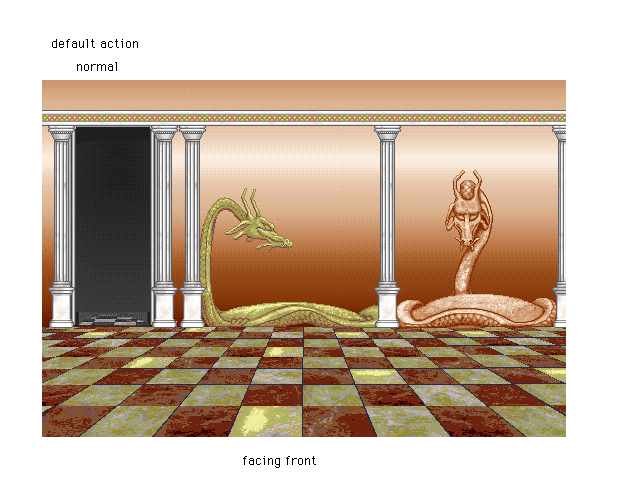
The above image was found in the WorldsAway Director file archives . Do you recall anything about this? It would be interesting to know if it was an early locale test, or if it was just simply to test artwork placement in Director before loading it inworld.
I remember drawing the dragons. <smile>
Flat 3 looks like a World Builder test. One of the guys was testing out a new composition and possible colours. I’m sure they put together quite a few tests in the process of building the areas that made up the world. As AD, I’d sometimes provide room ideas and connectivity suggestions, but it was truly up to them to put the world together in ways that worked and were attractive. Given that WA was a glorified chat room (with pretentions towards eventually adding some game-like features, for which I was allowed one Programmer), there needed to be LOTS of eye-candy to attract Users.
If someone had an idea for a piece of artwork, how would that be handled? Were there proper channels people had to go through?
The chief channel was me. I wasn’t that hard to reach. <smile> Occasionally my team would conspire to insert a surprise that they’d thought would particularly please me. So, obviously, all you really HAD to do was get a piece of art to a tech artist/World Builder (and they themselves were capable of generating art too). But people were courteous and went through me.
Did you get final approval on all pieces of artwork that were to be used inworld?
Until my last week at Avaterra, yes. Save for the one knicknack that appeared in my personal in-world apartment on my birthday while we were still Fujitsu. <smile> ((Thank you again, team, if any of you ever get to read this.))
Were there any pieces that made it into production that you did not approve of?
As long as you remember that I had no control over the colours and accessories the Users could choose and apply <smile>, no. Everything created during my tenure went through my approval.
When creating a new locale, did you use storyboarding to prototype it? If so, did you always do this and did the final product end up looking like the initial vision usually?
Sometimes I would storyboard a new area, very sketchily, but I always trusted my World Builders with the latitude to expand and improve upon the storyboard. The ONE time it didn’t quite work right was in the Zodiac rooms. The rooms were supposed to connect in the same order that the Zodiac shows in Earth’s night sky. Two rooms got exchanged. But we let it slide. It still looked great.
The Jungle was one area that benefited hugely from my trusting my World Builders. It was part of the original “plan” my predecessors had left me, but the plan was nowhere as lush and extensive and, frankly, creative, as the area created by my people became.
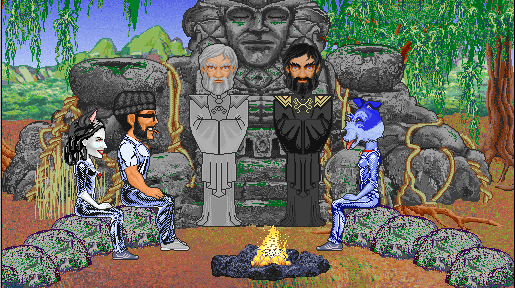
What was the process like for creating a new area? For example, would the Oracles come to you with an idea for an area, have the art team come up with some concepts and then have you create the artwork and build the regions as necessary?
That’s pretty much how it could and did at times happen. Most of the “concepts” were just verbal. MOST storyboarding was done for connectivity reasons/ mapping out what scene would connect with what other scene so that progression would seem natural. Some areas were my idea. Some were suggestions from my art staff, particularly the World Builders. The latter were a natural source because they knew better than anyone what could be built with all the pieces we already had and what new piece of art would be “perfect” to establish a new setting. I think of that as them giving ME an assignment. <smile>
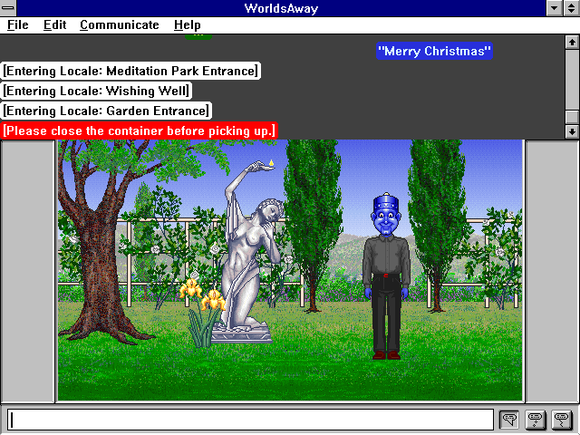
I had heard that the Meditation Park area of the Dreamscape was an idea the art team came up with, do you remember how it came to be?
A chunk of it was me, but, honestly, our team worked so closely together that it is often hard to say “I came up with that”. Often it was, essentially, group think. The original plan for the “city hall” or “temple” at the end of the promenade didn’t include anything else and didn’t have a real purpose. And, frankly, city hall is a kind of boring concept for an environment like WA.
I’d toyed with the notion of a more park-like area somewhere, but that meant getting away from the in-your-face relatively “close up” background styling of the building fronts, room interiors, and even the jungle. That’s when I decided I wanted to try the theatre concept of “flats” as scenery: a few pieces of large landscape “matte paintings” that were simply there for visual distancing. I figured using those in, maybe, 3 such Screens would literally “round out” the space between city hall and the end of the store fronts.
My World Builders took that concept and the statues I drew and produced a wonderful masterpiece. Far more than the 3 scenes I’d envisioned. I am so proud of the work they did! And it opened up whole new options: windows looking out on landscapes. The beach front. Etc.. While the Jungle is great, I think Meditation Park showed the team that we could really expand well beyond the original concepts, and that everyone could contribute real ideas to the world.
Did you ever have designs for artwork or regions/locales that never materialized?
Yes, of course. I didn’t intend to leave WA as abruptly as I did.. And there were so many possibilities we hadn’t yet touched on. We hadn’t even added in any of the features my games programmer had been working on. Or more bodies. More clothing styles. Animals. Out-of-this-world areas. You have all of human imagination to draw on with fantasy and science fiction worlds. Even the mundane, product-name-dropping worlds have their own fascination as a marketing tool.
Did you ever create regions inworld yourself?
No. My World Builders had trained themselves to a level of skill with our world construction tool that I never reached. I can draw a scene, but I couldn’t build it in the tools we were using.
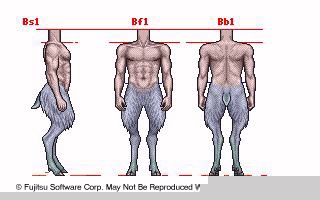
Can you tell us your memories of this body? The artwork was originally displayed on the WorldsAway website but never released to the public. Was it ever completed?
This body was not, to my knowledge, animated, if that is what you mean by “completed”.
A completed body is actually one that has been finished by the World Builders. The process was as so: Body design consisted of front, back, and side standing - just as this satyr is shown. Animation cells were then created for all the required animations: walking, sitting, opening the door, waving, etc., in all three positions. Those cells originally were specced to be built out of pieces, allowing as much re-use as possible, but also with as few pieces as possible - which made some/most animations awfully stiff.
In the versions 1.2 and 2 bodies, the limitation of “as few pieces as possible” was removed, and I instituted the idea of “as flexible as possible” particularly to the end idea of expanding the number of allowed animations in the future. (This idea failed in v1.2; it worked quite well in v.2.) Then the art files of body pieces moved on to the World Builder Artists, who re-constructed the animations according to the proprietary program WA used, and added the “contact points” wherewith heads could be attached and objects could be picked up, etc.. Then those files were sent on to Programming for insertion in the game.
The satyr looks to be from the time of v.2, the 2nd major overhaul of bodies. That was when I was already in charge of Customer Service as well as the Art Dept., and really didn’t have time to do bodies any more.
It looks like a test for what I mean by “flexible” in the use of Karen M’s work. However, all of our art resources had, by that time - before Fujitsu spun off Avaterra, been sent to Japan who had a parallel product running and had spent a great deal of time debriefing me on the development and construction of the American product. Clearly that was with the intent of producing a more Asian-oriented product on their end. So I no longer remember whether this particular body was produced in my studio or in the Japanese studio. I simply recognize the torso as Karen’s work. However, the detail of the goat half makes me think it was also Karen’s, but I may be wrong. At any rate, no animations were completed for this body in my studio.
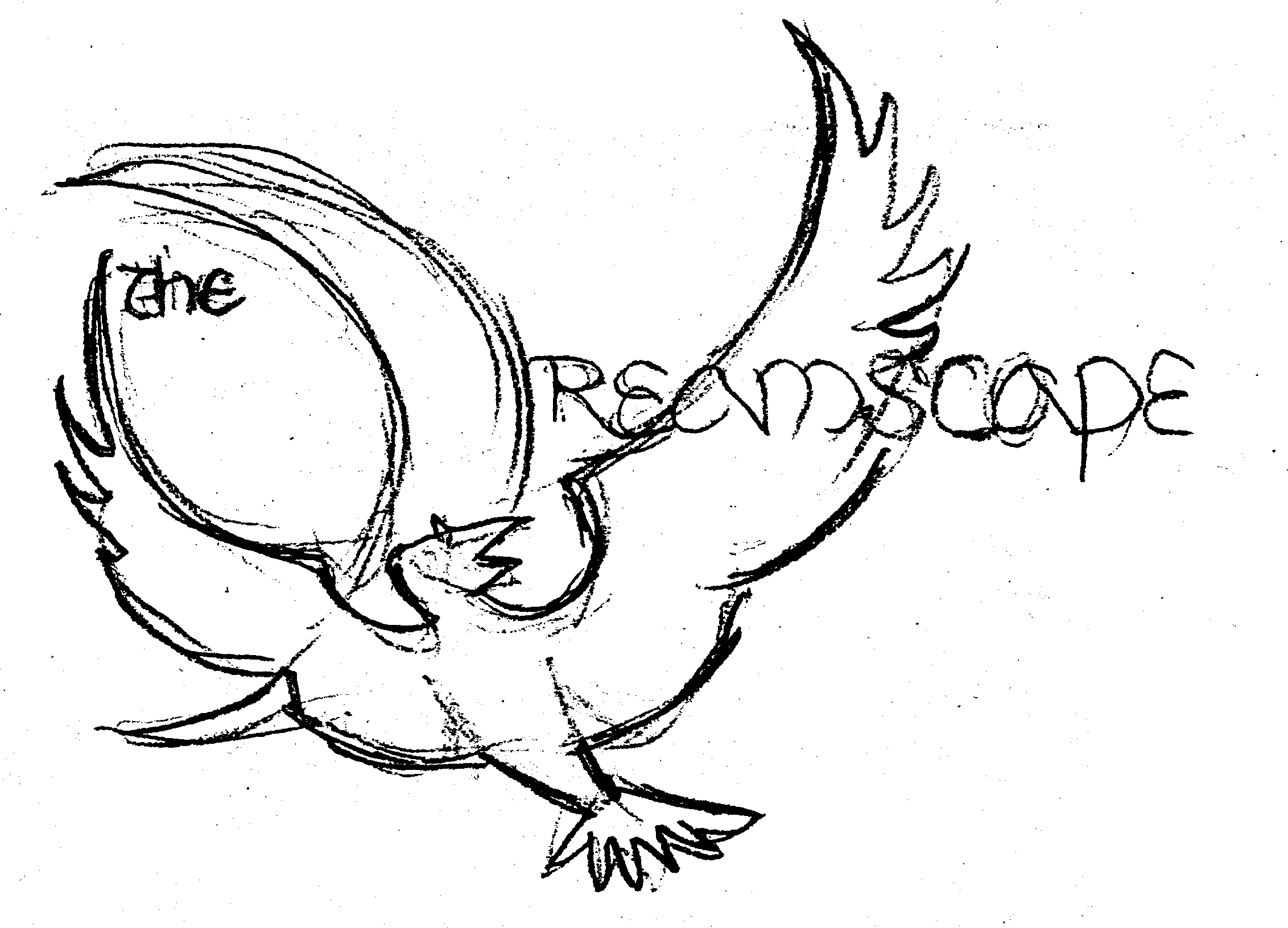
Oracle Vaserius sent me this a long time ago and said it was an early sketch for the Dreamscape logo that you created. Do you remember if this was the very first design for the logo? Were there alternate versions at all?
There were alternate sketches. More than a half dozen pages of thumbnails. I tend to brainstorm lots of ideas on my sketchpads. I would have to hunt and see if I still have those sketchpads and if I can recognize which sketch came first. I don’t remember.
I looked. This particular sketch comes about half way through some 10 pages of thumbnails. Each page had 3-7 thumbnails.
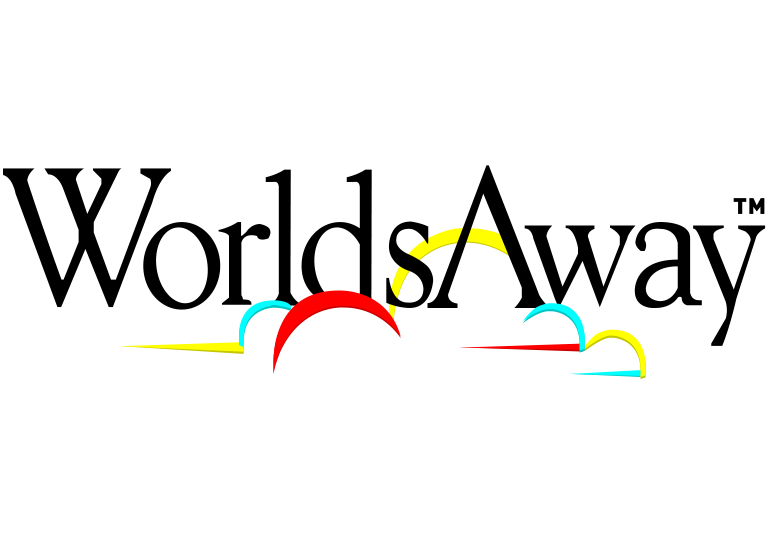
Do you remember who designed the WorldsAway logo? I wasn't sure if it was outsourced or if it was done inhouse. I also remember seeing several variants of the logo with the "Ghost" cloud colors being different each time (sometimes the aqua blue here was more of a navy blue for example).
I believe the cloudscape logo was not outsourced. But then… it depends on what you think of as “outsourced”. I hired lots of freelancers, several - but not all - of whom worked in-house. Most of the time, I was the only artist-animator who was a full time employee; and my world building staff were all full time employees. The other artists were freelancers. I vaguely recall a version of the cloudscape in my sketchbook, but I’d have to hunt those up in order to be sure. I did not come up with the final form.
I don’t actually remember who did the final rendering. I’m pretty sure that I did not. I don’t actually think the final rendering was inhouse. We did experiment with colors and cloud sizes. I remember rejecting the navy blue because, on some monitors, it was too close to the black of the words.. and I wanted the clouds to seem “lighter” than the words. But.. clearly we went with the yellow - and I HATE yellow if it’s usually displayed on a white background: it disappears at a distance and so becomes unreadable. (Just as navy or dark red on black is bad design, becoming unreadable at a distance.) On the other hand, I know one of the intentions was that we could vary the colors if we wanted: perhaps for holiday themes or some such. But I don’t recall ever doing so.
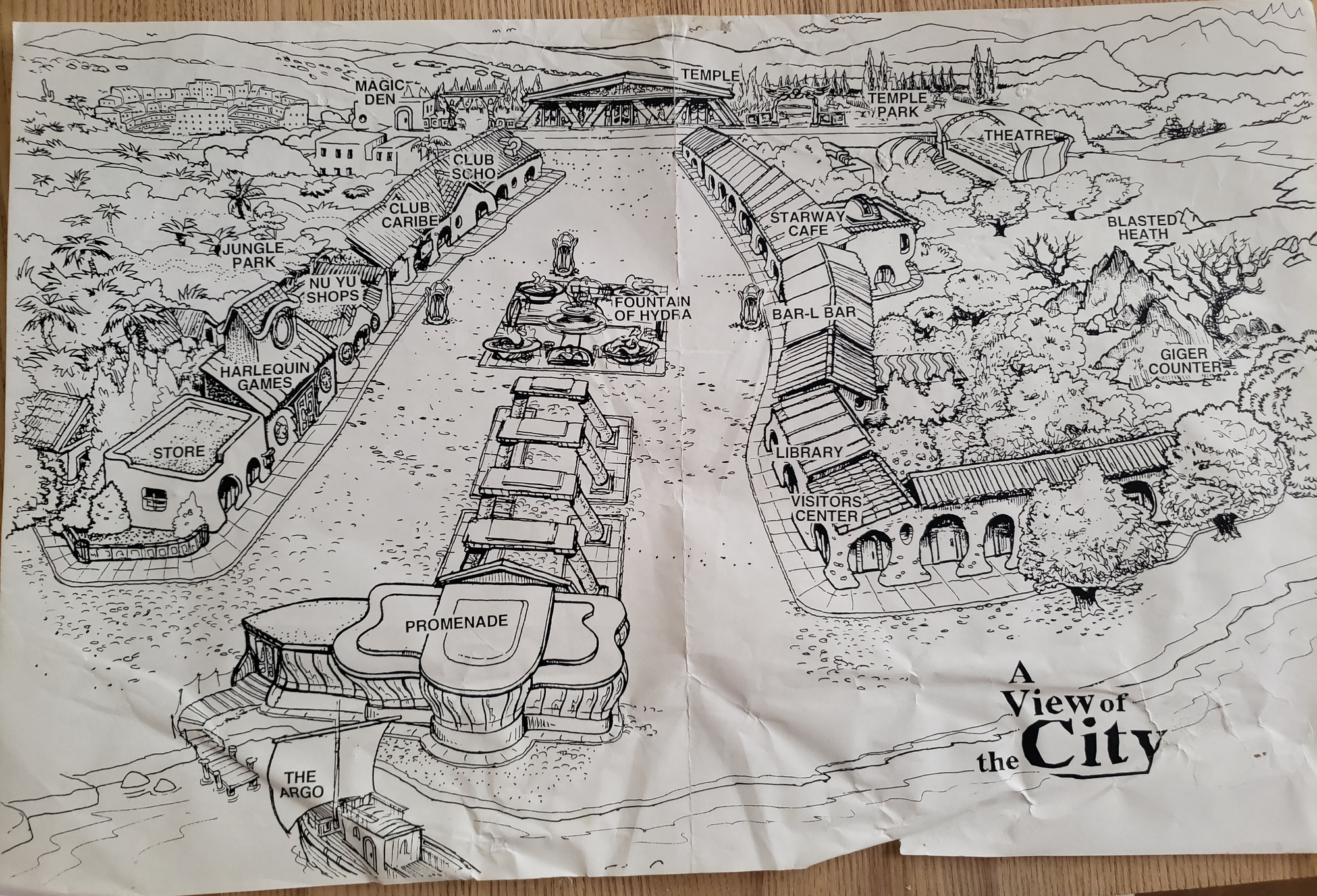
Do you remember who created this initial map of the Dreamscape and why it wasn’t used later on?
I remember Paul showing me a sketch the first day. I don’t think it was this one. This seems too detailed. But my memory is vague. I think Vaz may have kept that original sketch during my tenure. I certainly didn’t have it in my files and didn’t have it to use for ideas/ brainstorming.
I now see the Temple and Temple Park which one might think inspired city hall and Meditation Park, but, honestly, the temple idea had been pretty much forgotten by the time we reached that end of the world. Perhaps because the word “temple” has religious connotations and we wanted to be all-inclusive and not single out any particular faith system. So.. this may have been the work of one of my staff when Marketing wanted some “real art”. Joe would have been the likely choice.
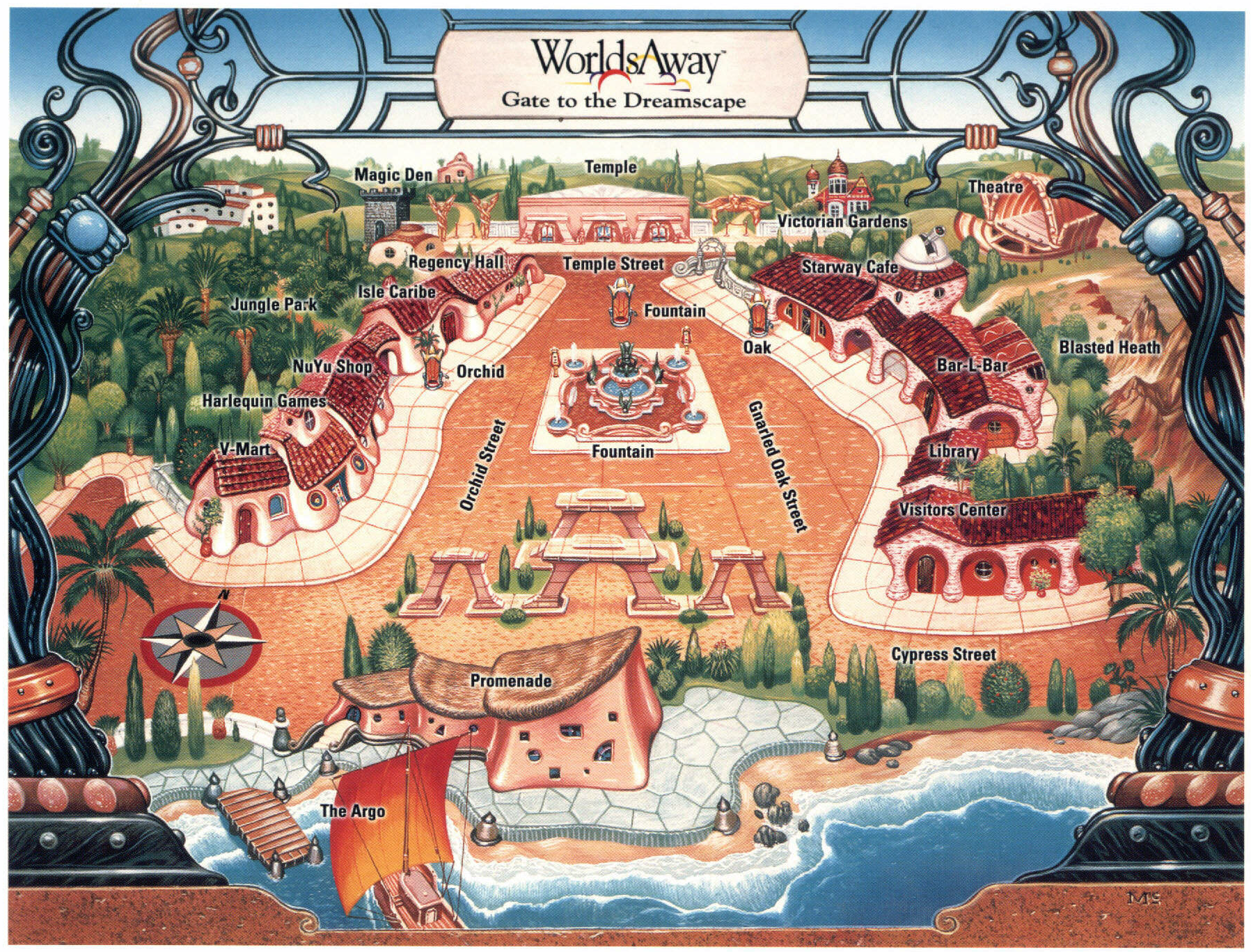
Another map of the Dreamscape was created later on which Vaz highly disapproved of (he said the Promenade looked like a building from the Flintstones). Do you remember why the higher ups had the map redrawn?
I think the Marketing wanted some WorldsAway tchotchkes for some convention or another. Our piecemeal art didn’t lend itself to that!
This was used as a poster and as a mouse pad. It does look rather Flintstone-y, doesn’t it. <smile> Friendly. I didn’t mind it, really, save for the fact that a map implies a game, and WA was really a chat center.
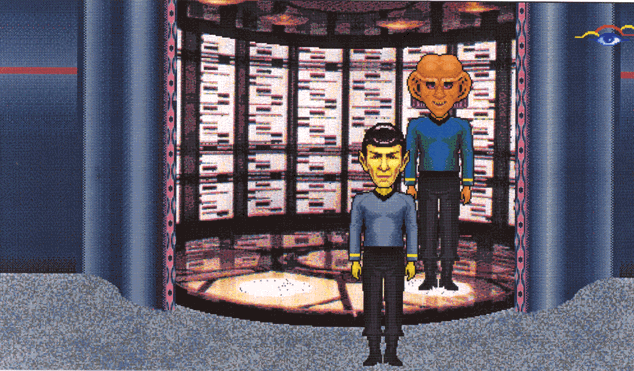
Greg mentioned that Fujitsu were courting Paramount at one time and trying to sell them on the WorldsAway technology. Do you remember anything about this project?
We courted and were courted by a great many companies. The virtual chatroom was just a concept for, say, far flung business compatriots that needed a quick meeting. Or as an interface for online shoppers. We even were considered an option for one computer security company because the feature of changing your voice/having actual voice contact as well as typing your conversations was a possibility for WA.
I remember this piece (and really only that) as well as several similar projects where prototype art was produced. If we were willing to do prototype animation, it could all be placed in a separate area “in world”, but it would never be added to the actual production WA database, because, after all, it was proprietary to whoever we were having discussions with.
(Of course there were Star Trek fans amongst us. How can one work in the early days of computers and computer gaming and not have a science-fiction-y bone in your body? <smile>)
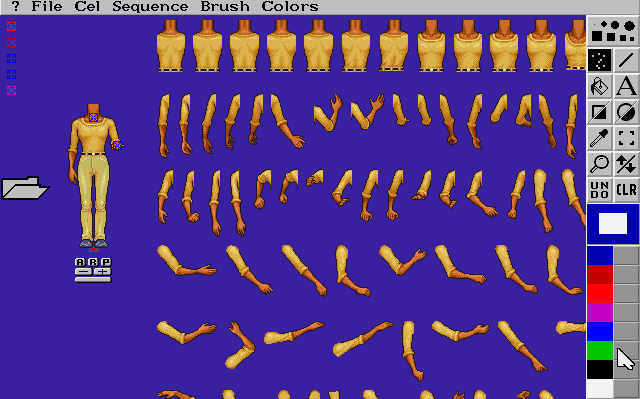
Do you remember anything about Animax and how that came to be used by the Art Team? Was it used alongside Director or was it intended to replace Director?
Both Karen and I knew the designer of Animax personally. I met him when I was AD at Electronic Arts. It was a good tool and I liked it a lot. Animation formats - even art formats - weren’t all that standardized back in those days, however. So the art processing for WorldsAway didn’t incorporate actual animation files. An artist could use Director (or Animax) to develop her animations, but it would still have to be delivered to our tech artists in the format that WA’s proprietary tools required. Like I said, I didn’t care what tools an artist used, as long as the finished result was what we needed, in the right format, on time.
Do you recall anything about a pet project of Vaz’s named Giger Counter? He mentioned it was to have some H.R. Giger influence.
If you look at the maps closely, you will see one of the store fronts entitled Giger Counter. I hadn’t realized that it was a pet project of Vaz’s. That makes me sad that we never did something with it. Vaz presented himself as a bit goth, back then. I merely like H.R.Giger’s artwork.
One of the problems with Giger’s art, though, is that it is distinctive enough that it’s hard to be influenced without it looking like Giger’s work. If the name was used as well, we’d probably be butting up against copyright infringement. I never heard if Fujitsu even tried to get permission from Giger’s lawyers. That’s probably why the project never got far. But I don’t know.

Do you recall anything about a world named “Affinity”?
No. I don’t recognize parts of this art work either, like the trophies behind glass. But then my memories have faded a lot. This may have been done after my time? This is clearly a sports-themed area, and that certainly sounds like something we’d test out for a potential client.
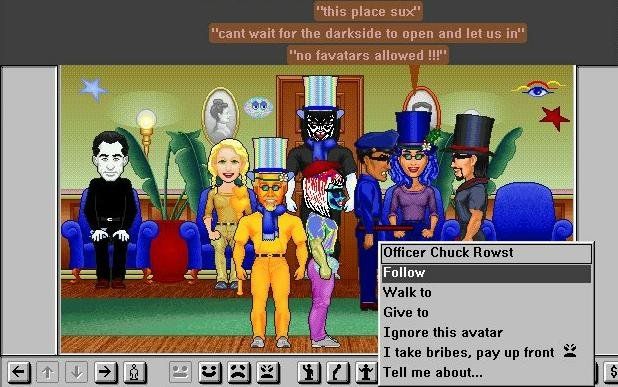
Do you recall anything about the Hallway world which later became Hotel Silicon?
I don’t really remember this, although Hotel Silicon sounds familiar and I once made a piece of art using that name. I think the hallways (and hotel) concepts were an early idea for how to implement the Users-can-have-their-own-apartment notion. I know we implemented apartments, but, art-wise, the notions of hotel, hallway, and apartment were easily done with existing art and didn’t take much thought on my part.
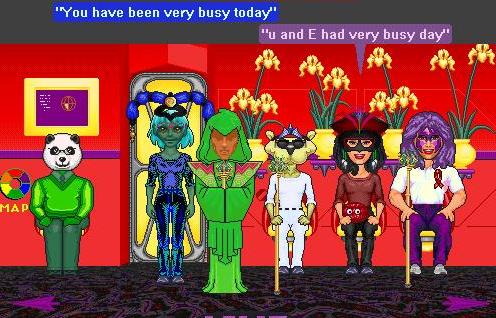
Do you remember anything about the world named Pride which was based on a Spaceship and had a LGBT focus?
Pride must have been after my time. That combination of red and yellow would have been difficult to look at for very long, for me. I’m actually very happy that the LGBT crowd had an online presence via WA. Seems like a very good use of the technology.
Authors note: - Pride was actually launched in October 1996, but wasn't an inhouse Fujitsu development. A company named Pride Media Ltd licensed WorldsAway from Fujitsu and contracted them to build the world. Greg Specht contributed regions to the world and as Sheryl didn't build regions, it's likely she had very little if anything to do with Pride hence her not having a memory of it.
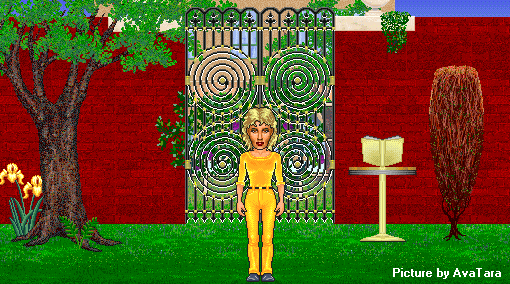
Do you have any memories of working on the world which became known as Club Connect? It might’ve been known earlier internally as the “adult” world. It later got renamed to “New Radio World” and “VZConnections”
We were working on ideas that could be implemented in an adult world when I left Avaterra. It was a concept that had a lot of appeal for our upper management. I do remember having to point out that adding extra animations (like kissing) would take a significant database and programming change (not to mention how to deal with heads of different sizes and lip locations), and that hugging was equally difficult as we had no proximity sensing techniques and, given no set of bodies, (until the Tarzan and Jane bodies), were made of exactly the same pieces AND the pieces were differing sizes, we had no way to “interlace” them in a hug. It would require re-writing code and re-processing every body, head, and accessory in the world. Some things seem easy when the technical underpinnings are not understood.
The name Club Connect even sounds vaguely familiar. But I don’t have any specific memories. I do love that door in the picture!
Did you ever spend time inworld socially at all?
No, not really. I “played tourist” to judge the impact of what my people had produced. I participated in those in-world events where the Oracles wanted the Art Director (I think A.D. was my avatar name, but I don’t remember) as a real presence to answer questions. Still, my job did not entail me being in-world for the most part; I had work to do.
Was there a social scene at Fujitsu? Did people hang out outside of work at all?
Fujitsu was, by and large, a Japanese company. Japanese companies at the time really didn’t want their Japanese employees to get too acclimated to the United States, because that made re-integration into Japanese society difficult. After the first restructuring, Brian, my male counterpart head of Programming, would go golfing with the other Japanese managers, because that was an acceptable socialization venue for a male. As an American female manager, I didn’t really have a place in the management social scene. But that was also true in many of the American companies I worked for before and after. A female essentially on the engineering side of a project was rare, back in the day.
I did socialize with my team when I took them out on field trips. And several of “my” artists were people I socialized with in various contexts before and after Fujitsu: artists’ coffee klatches, sketch sessions, SCA, comic or s-f conventions, costume societies, etc.. However, as a working mother, I had limited free time, so mostly I wasn’t free for spontaneous “hanging out” after work. After I left the project, I didn’t want to socialize with anyone who I hadn’t known outside the WA context, simply because I didn’t want to explain why I had left. I figured that could prejudice them against the people now in charge of their jobs, and I didn’t want to do that. I didn’t want to put their jobs at risk. But I’ve always enjoyed hearing about what they’ve done since. In some sense, I will always think of them as “mine”. <smile> People I cared about.
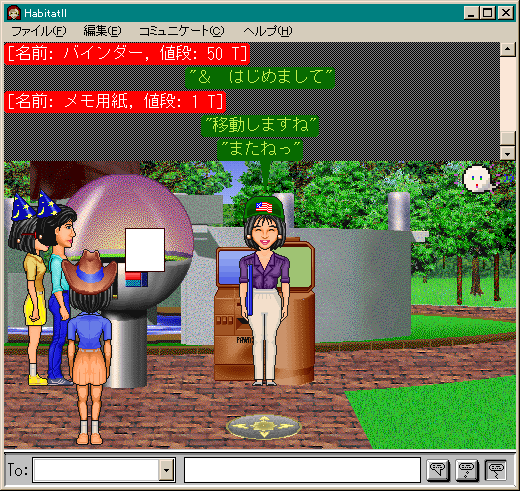
What were your interactions like with the Habitat II team in Japan originally before you were debriefed about everything? Would it be normal for them to send you art requests or ask that you process art for them for example?
My connection with the Japanese team was, by and large, completely non-existent. They never made requests of me or my technical artists. Or, if they did, those requests came down via Tony and I didn’t know they came from Japan. I never knew what the state was of Habitat II at any time during my tenure at Fujitsu.
There were two exceptions to that overall idea.
One. Late in my tenure on the project but before we were spun off as Avaterra, Fujitsu Japan arranged a personal de-briefing. A couple of their AD/management types and I took a week (I don’t think it was 2 weeks), while I went over, step by step, everything I knew about the WA project: its concept, art creation, tools, the binders, art management, and customer service management. And the “whys” behind our practices. We had to pull in a secretary from upstairs because, although I speak Japanese from my childhood in that country, I had no Japanese vocabulary for art and computer and management topics. A child wouldn’t. That secretary later told me that she loved the experience of translating for us because she learned so much. That week was very cordial and I had hopes that our differing worlds might mutually benefit from exchange. That never happened, at least for us in San Jose.
Two. I had a very limited in-house customer service staff after Vaz left, and was not allowed to expand much. So we used a lot of in-world volunteers. After a while, it became very clear that the in-world people were, perforce, performing full-time jobs and deserved actual compensation. In short, we should hire them. Fujitsu-Japan seemed bemused (if not agast), returning with, “Why don’t you do what we do in Japan: use Fujitsu wives. They work for free.” <sigh> I had to very patiently explain that business did not work that way in the USA. If I hired someone’s wife, I would still have to pay her a salary and benefits. That folks in the USA only worked for free for charities. Not profitable Big Business companies, even if said company employed a family member. Such was the difference in cultures.
Was it clear to you at the time that Fujitsu were looking to offload the WorldsAway group? Or did it just seem like they just wanted to expand the Japanese side of the business.
At the time, I was completely convinced that Japan admired our success with WA and wanted to incorporate some of what we had done into the Japanese version/Habitat II. I had no clue that they intended to spin us off. Given that they truly seemed interested in learning from us, it didn’t make sense. I was naive.
It’s been said that Fujitsu in Japan mostly cared about getting their investment into the product back and didn’t care about much else. In your experience, would you say this is a fair assessment? Do you recall any situations where they made it clear they only cared about the bottom line?
For most of my time at Fujitsu, having a little experience with Japanese culture from my childhood, I remember being puzzled, wondering why a mostly-hardware company was actually doing something as creative as WorldsAway. And I couldn’t understand why we weren’t given some of the more innovative Fujitsu hardware - monitors and such that I’d seen in the consumer electronics shows - to make our jobs easier. But I was largely happy in my job and let those thoughts slide.
I didn’t generally feel that Japan only cared about the bottom line… except one time when I was doing another spreadsheet for Japan, showing the cost of the current art and estimating the costs for planned art. Standard stuff. A Japanese accountant reviewing my numbers told me that Japan would never accept them: I’d have to change them. I said “No”. The numbers reflecting what had been spent were true, and the numbers estimating the future were as good as I could make them. If the numbers had to be changed then the scope of the design must be reduced. I couldn’t, in good conscience, pay people less than what they’d earned. I never found out what they ended up doing. But I refused to back down from my analysis, and the project continued.
However, the telling point truly was - having placed me as figurehead for the WorldsAway product - and given me and Brian, the head of Programming, defacto responsibility for running the entire team (albeit not for interactions with Japan) - the head of the San Jose Fujitsu office called us into his office to tell us Fujitsu had sold us to a venture capitalist… which shocked us. Well, I called him out, reminding him of his promises to give us the appropriate promotions and compensation for the work we’d been doing; he said, simply, “I lied to you.”
I vaguely admire the man for that bit of honesty. Most American corporate presidents would not be that honest. But you can imagine how I felt.
Lastly, I felt that Fujitsu didn’t think of their American employees as they thought of their Japanese employees when I found out, after I’d left, that my savings plan through them had been essentially wiped out by a technicality. <sigh>
Thus I honestly can’t tell you if I feel Fujitsu was better or worse than any of the other Big Companies I have worked for. Time has shown that Big Business in the USA does not have any incentive to actually care about its employees; whereas employees are always prone to care about a company when they have work about which they feel pride.
When did you find out the WorldsAway group was being sold? Do you remember what or how you were told? (perhaps it was an internal memo or a face to face meeting)
I do recall, despite being told that Brian and I were in charge of the entire project, noticing that my boss Tony seemed very preoccupied and, yes, quite unhappy - although never at us. He had to have known what was going on behind the scenes with Fujitsu and the venture capitalist. I believe it was that that made him unhappy. In retrospect, he had to have known that our “virtual promotions” were simply a ploy to keep the team all together so that the sale could go through. In effect, the team trusted me and Brian, so we were an unaware “smoke screen” for what Fujitsu was planning.
Do you remember the general feeling amongst the team at this time regarding the sale and their job security/future of the service?
We were still mostly positive. After all, we’d done good work and launched a successful product which benefited from continued maintenance. There was still a lot of potential in the technology. We thought the venture capitalist saw that.
As someone who was handling Customer Service as well as the Art team, did you ever have many dealings with the venture capitalist? They were the former VP of the WorldsAway Group at FSBA from late 1998 and later in May 1999, CEO of Avaterra)
I had contact with him on an almost daily basis, both while he poked around Fujitsu and at Avaterra. While at Fujitsu, I had no idea of his purpose. We’d done “guided tours” of the project for many interested people. He was just one more.
I didn’t have any way to evaluate him professionally, except that he had obviously successfully negotiated with Fujitsu. So I trusted he would do right by us. He’d bought us, after all.
At Avaterra, however, he proved a distinct problem for our Customer Service group. We had a hard-and-fast rule that no Oracle or WA employee could show favouritism to any User. That particularly meant no inworld gifts of items or heads, etc., unless as part of a planned Event. The venture capitalist used his avatar to give gifts to Users he liked, and pooh-pooed our examples of how that sort of behaviour creates real morale problems in our customer base. We had always promoted absolute fairness to our customers, and he would not respect that rule.
Once Avaterra had taken over, was any new artwork created by your studio for WorldsAway? Or was everything done in house in Japan by that point?
Nothing was being done by Japan while I was at Avaterra. I’m not sure how it legally could, given we were no longer part of Fujitsu. But I was not party to the legal or financial arrangements. The move to Avaterra essentially “demoted” me back to managing the art and customer service teams, which was all I’d ever been paid to do anyway.
My team continued to do art, both for the on-going product, and for potential new partners. I remember a bank-oriented theme. And quite a lot of product-placement test art. I think most of my hopes for adding real game features were nixed, however. I don’t recall if I still retained my game programmer at the time. I just don’t remember. A lot of my final memories are coloured and obscured by the nature of my resignation from Avaterra, which I personally found most distressing.
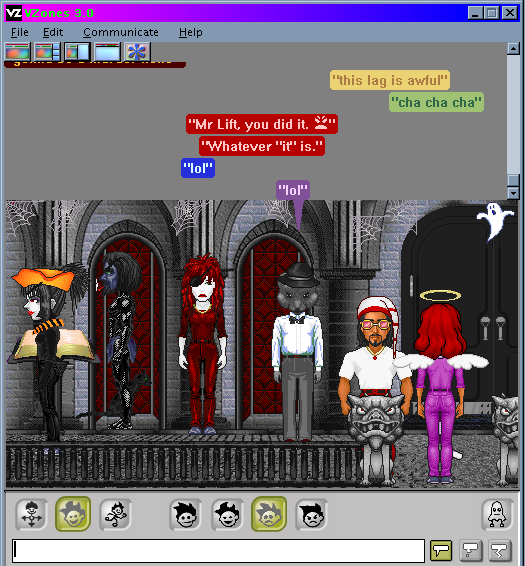
The WorldsAway 3.0 client had been planned for a while and during your time at Avaterra, it was released in a neutered form as VZones 3.0. Do you remember about the original plans for WorldsAway 3.0 and features/upgrades it might have had?
I’m a gamer. I’ve referred to my game programmer. In my plans, WA 3.0 was to implement features that would allow parts of the world to become platforms for gaming, not just a chat room. In some sense, it was to become a predecessor for those MMORPG games that are so prevalent now. I have always thought of it that way.
Avaterra wasn’t in existence for very long and it seemed like a tumultuous time from the outside looking in. How was that chapter for you compared to the 4 years prior you had spent working at Fujitsu?
Painful. Disillusioning. I really don’t talk about it.
Did you have plans and ideas whilst working at Avaterra that never got to materialise?
My plans at Avaterra didn’t differ that much from my plans at Fujitsu: the technology had a lot of potential. I wanted us to explore it.
Were many of the original WorldsAway team still working with you at Avaterra or had they moved on?
All of my employee art team came with me to Avaterra, although the freelancers did not.
Was it your decision to leave Avaterra?
I turned in my resignation, so, yes, it was my decision. The morning I did so was when I’d discovered I could not work for such people any longer. I was escorted out as soon as I’d packed my things, which <smile> took a bit of time, because the entire art reference library we’d used was my personal property.
If you could go back and change anything about your time working on WorldsAway, what would it be?
I should have turned in my resignation when I was told I’d been lied to. But I really wanted to make sure my team made the transition safely.
Was there ever a feature you wish you had in WorldsAway that you thought would have been cool? (For example, vehicles, documents, inworld pets, etc)
All of those! And more! Acrobatic moves, for instance.
What’s your favourite piece of artwork you designed for WorldsAway and why?
It’s possible I once had some favourites, but I don’t remember now. I like a great many things I did for WA. I always tried to do good work within the limitations I was given.
Do you have a least favourite piece of artwork that made it inworld?
The heavy male body. In fact, all three of the first bodies bother me still. I can do so much better!
Do you still draw and paint today?
Yes, although the carpal tunnel syndrome I developed at Fujitsu prevents me from doing a lot of it. I can’t do a full workday of art any more.